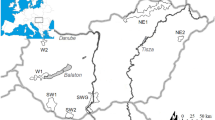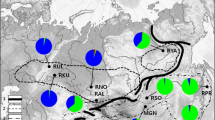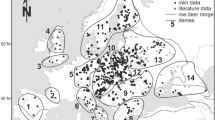Abstract
Red deer (n = 149) from eight geographical locations, including the endangered endemic populations from the Tyrrhenian islands (Sardinia and Corsica), were analysed at eight polymorphic microsatellite loci. Two questions were addressed: (1) Is there a founder effect in the Corsican population, which was reintroduced to the island using Sardinian deer after the species’ extinction on Corsica? (2) What is the origin of the Tyrrhenian or Corsican red deer (Cervus elaphus corsicanus)? Our results showed signs of a founder effect for the red deer on Corsica in that these deer showed differentiation from the Sardinian population as measured by FST values, assignment tests (with and without a priori definition of populations) and individual-based dendrograms. Genetic variability, however, did not differ significantly between the two populations. With respect to the phylogeography of C. e. corsicanus we found that both deer from North-Africa and Mesola on the Italian mainland were genetically close to the Corsican red deer, but phylogenetic trees based on genetic distances were only poorly supported statistically. Among all populations studied the Mesola red deer showed the lowest distance values from Corsican red deer and yielded allele frequencies that were more similar to those of C. e. corsicanus than were those of North-African red deer. These results are in line with recent palaeontological and archaeozoological findings which suggest that the Corsican red deer is derived from small Italian red deer introduced from the mainland to Sardinia and Corsica during the Late Neolithic and just before the beginning of Classical Antiquity, respectively. They also suggest a possible recent introduction of Tyrrhenian red deer to North-Africa (rather than the other way around), thus accounting for the close genetic relationship (especially based on mitochondrial DNA) that has repeatedly been found between C. e. corsicanus and C. e. barbarus.



Similar content being viewed by others
References
Avise JC (1989) Gene trees and organismal histories: a phylogenetic approach to population biology. Evolution 43:1192–1208
Avise JC (2000) Phylogeography. The history and formation of species. Harvard University Press, Cambridge
Banwell B (1998) Description of Cervus elaphus corsicanus. IUCN Deer Spec Group Newslett 14:9
Blondel J, Vigne J-D (1993) Space, time and man as determinants of diversity of birds and mammals in the mediterranean region. In: Ricklefs RE, Schluter D (eds) Species diversity in ecological communities. Historical and geographical perspectives. Chicago University Press, Chicago
Bonnet A, Thévenon S, Maudet F, Maillard JC (2002) Efficiency of semi-automated fluorescent multiplex PCRs with 11 microsatellite markers for genetic studies of deer populations. Anim Genet 33:343–350
Bowcock AM, Ruiz-Linares A, Tomfohrde J, Minch E, Kidd JR, Cavalli-Sforza LL (1994) High resolution human evolutionary trees with polymorphic microsatellites. Nature 368:455–457
Cavalli-Sforza LL, Edwards AWF (1967) Phylogenetic analysis: models and estimation procedures. Am J Hum Genet 19:233–257
Cheylan M (1991) Patterns of Pleistocene turnover, current distribution and speciation among Mediterranean mammals. In: Groves RH, Di Castri F (eds) Biogeography of Mediterranean invasions. Cambridge University Press, Cambridge
Cornuet JM, Piry S, Luikart G, Estoup A, Solignac M (1999) New methods employing multilocus genotypes to select or exclude populations as origins of individuals. Genetics 153:1989–2000
Costa L, Vigne J-D, Bocherens H, Desse-Berset N, Heintz C, de Lanfranchi F, Magdeleine J, Ruas M-P, Thiébault S, Tozzo C (2003) Early settlement on Tyrrhenian islands (8th millennium cal. BC): mesolithic adaptation to local resources in Corsica and Northern Sardinia. In: Larsson L, Kindgre H, Knutsson K, Loeffler D, Åkerlund A (eds) Mesolithic on the Mour. Oxbow Books, Oxford
Cronin MA (1993) Mitochondrial DNA in wildlife taxonomy and conservation biology: cautionary notes. Wildlife Soc Bull 21:339–348
Davis SJM (1987) The archaeology of animals. Batsford Ltd., London
Dobson M (1998) Mammal distributions in the western Mediterranean: the role of human intervention. Mammal Rev 28:77–88
Dolan JM (1988) A deer of many lands—a guide to the subspecies of the red deer Cervus elaphus L. Zoonooz, LXII(10):4–34
Estonba A, Solís A, Iriondo M, Sanz-Martín MJ, Pérez-Suárez G, Markov G, Palacios F (2006) The genetic distinctiveness of the three Iberian hare species: Lepus europaeus, L. granatensis, and L. castroviejoi. Mamm Biol 71:52–59
Ewen KR, Bahlo M, Treloar SA, Levinson DF, Mowry B, Barlow JW, Foote SJ (2000) Identification and analysis of error types in high-throughput genotyping. Am J Hum Genet 67:727–736
Felsenstein J (1993) PHYLIP (Phylogeny Inference Package) version 3.5c. Distributed by the author. Department of Genetics, University of Washington, Seattle
Feulner PGD, Bielfeldt W, Zachos FE, Bradvarovic J, Eckert I, Hartl GB (2004) Mitochondrial DNA and microsatellite analyses of the genetic status of the presumed subspecies Cervus elaphus montanus (Carpathian red deer). Heredity 93:299–306
Flerov CC (1952) Musk deer and deer. In: Fauna of the USSR. Mammals, vols 1, 2. Academy of Sciences, Moscow
Fonzo O (1987) Reperti faunistici in Marmilla e Campidano nell’Età del Bronzo e nella prima Età del Ferro. In: La Sardegna nel Mediterraneo tra il secondo et il primo millennio a.C. Amministrazione Provinciale, Cagliari
Funk DJ, Omland KE (2003) Species-level paraphyly and polyphyly: frequency, causes, and consequences, with insights from animal mitochondrial DNA. Ann Rev Ecol Evol Syst 34:397–423
Geist V (1998) Deer of the world. Their evolution, behavior, and ecology. Stackpole Books, Mechanicsburg
Gonzalez G, Kidjo N (2002) A research project on conservation biology of Corsican red deer (Cervus e. corsicanus). IUCN Deer Spec Group Newslett 17:1–3
Goodman SJ, Tamata HB, Wilson R, Nagata J, Tatsuzawa S, Swanson GM, Pemberton JM, McCullough DR (2001) Bottlenecks, drift and differentiation: the population structure and demographic history of sika deer (Cervus nippon) in the Japanese archipelago. Mol Ecol 10:1357–1370
Goudet J (1995) FSTAT (version 1.2): a computer program to calculate F-statistics. J Hered 86:485–486
Groves CP, Grubb P (1987) Relationships of living deer. In: Wemmer CE (ed) Biology and management of the Cervidae. Smithsonian Institution Press, Washington
Hadjouis D (1990) Megaceroides algericus (Lydekker, 1890), du gisement des Phacochères (Alger, Algérie). Etude critique de la position systématique des Mégacéroides. Quaternaire 1:247–258
Hajji GM, Zachos FE, Charfi-Cheikrouha F, Hartl GB (2007) Conservation genetics of the imperilled Barbary red deer in Tunisia. Anim Conserv 10:229–235
Hartl GB, Nadlinger K, Apollonio M, Markov G, Klein F, Lang G, Findo S, Markowski J (1995) Extensive mitochondrial-DNA differentiation among European Red deer (Cervus elaphus) populations: implications for conservation and management. Z Saeugetierkd 60:41–52
Hartl GB, Zachos F, Nadlinger K (2003) Genetic diversity in European red deer (Cervus elaphus L.): anthropogenic influences on natural populations. CR Biologies 326:S37–S42
Hmwe SS, Zachos FE, Eckert I, Lorenzini R, Fico R, Hartl GB (2006a) Conservation genetics of the endangered red deer from Sardinia and Mesola with further remarks on the phylogeography of Cervus elaphus corsicanus. Biol J Linn Soc 88:691–701
Hmwe SS, Zachos FE, Sale JB, Rose HR, Hartl GB (2006b) Genetic variability and differentiation in red deer (Cervus elaphus) from Scotland and England. J Zool 270:479–487
Kalz B, Jewgenow K, Fickel J (2006) Structure of an otter (Lutra lutra) population in Germany–results of DNA and hormone analyses from faecal samples. Mamm Biol 71:321–335
Kidjo N, Feracci G, Bideau E, Gonzalez G, Marchand B, Aulagnier S (2006) Extinction and reintroduction of the Corsican red deer in Corsica. In: Abstracts of the 1st European congress of conservation biology “Diversity for Europe”, Eger, Hungary 22–26 August 2006
Kowalski K, Rzebik-Kowalska B (1991) Mammals of Algeria. Polish Academy of Science, Wroklaw
Krumbiegel I (1982) Der Korsika-Rothirsch (Cervus elaphus corsicanus, Erxleben 1777) und sein Biotop. Saeugetierkdl Mitt 30:281–286
Lorenzini R, Fico R, Mattioli S (2005) Mitochondrial DNA evidence for a genetic distinction of the native red deer of Mesola, northern Italy, from the Alpine populations and the Sardinian subspecies. Mamm Biol 70:187–198
Lovari S, Cuccus P, Murgia A, Murgia C, Soi F, Plantamura G (2007) Space use, habitat selection and browsing effects of red deer in Sardinia. Ital J Zool 74:179–189
Ludt CJ, Schroeder W, Rottmann O, Kuehn R (2004) Mitochondrial DNA phylogeography of red deer (Cervus elaphus). Mol Phylogenet Evol 31:1064–1083
Lydekker R (1898) The deer of all lands. A history of the family Cervidae living and extinct. Rowland Ward, London
Masseti M (1996) The postglacial diffusion of the genus Dama Frisch, 1775, in the Mediterranean region. Suppl Ric Biol Selvag 25:7–29
Masseti M (1998) Holocene and anthropochorous wild mammals of the Mediterranean islands. Anthropozoologica 28:3–20
Masseti M (2002a) Uomini e (non solo) topi. Firenze University press, Florence
Masseti M (2002b) The red deer of Lampedusa (Pelagian islands, Italy): literary references and osteological evidence. Arch Nat Hist 29:51–66
Mattioli S (1990) Red deer in the Italian peninsula with particular reference to the Po delta population. Deer 8:95–98
Mattioli S, Fico R, Lorenzini R, Nobili G (2003) Mesola red deer: physical characteristics, population dynamics and conservation perspectives. Hystrix Ital J Mammal 14:87–94
Mattioli S, Meneguz PG, Brugnoli A, Nicoloso S (2001) Red deer in Italy: recent changes in range and numbers. Hystrix Ital J Mammal 12:27–35
Mayr E (1963) Animal species and evolution. The Belknap Press of Harvard University Press, Cambridge
Minch E. Ruiz-Linares A, Goldstein D, Feldman M, Cavalli-Sforza LL (1995) MICROSAT (version 1.5b): a computer program for calculating various statistics on microsatellite allele data. Stanford University Press, Stanford
Nei M (1972) Genetic distance between populations. Am Nat 106:283–292
Nussey DH, Pemberton J, Donald A, Kruuk LEB (2006) Genetic consequences of human management in an introduced island population of red deer (Cervus elaphus). Heredity 97:56–65
Pamilo P, Nei M (1988) Relationships between gene trees and species trees. Mol Biol Evol 5:568–583
Pemberton JM, Slate J, Bancroft DR, Barrett JA (1995) Nonamplifying alleles at microsatellite loci: a caution for parentage and population studies. Mol Ecol 4:249–252
Pereira E (2001) Cervus elaphus rossii (Mammalia, Artiodactyla), a new endemic sub-species from the middle Pleistocene in Corsica. Palaeovertebrata 30:189–213
Piry S, Alapetite A, Cornuet J-M, Paetkau D, Baudouin L, Estoup A (2004) GENECLASS2: a software for genetic assignment and first-generation migrant detection. J Hered 95:536–539
Pritchard JK, Stephens M, Donnelly P (2000) Inference of population structure using multilocus genotype data. Genetics 155:945–959
Raymond M, Rousset F (1995) GENEPOP (version 1.2): population genetics software for exact tests and ecumenicism. J Hered 86:248–249
Redeker S, Andersen LW, Pertoldi C, Madsen AB, Jensen TS, Jørgensen JM (2006) Genetic structure, habitat fragmentation and bottlenecks in Danish bank voles (Clethrionomys glareolus). Mamm Biol 71:144–158
Rice WR (1989) Analyzing tables of statistical tests. Evolution 43:223–225
Sambrook J, Russel DV (2001) Molecular cloning: a laboratory manual. Cold Spring Harbour Press, New York
Scandura M, Iacolina L, Ben Slimen H, Suchentrunk F, Apollonio M (2007) Mitochondrial CR-1 variation in Sardinian hares and its relationships with other old world hares (Genus Lepus). Biochem Genet 45:305–323
Schneider S, Roessli D, Excoffier L (2000) Arlequin ver 2.000: a software for population genetics data analysis. Genetics and Biometry Laboratory, University of Geneva, Switzerland
Schüle W (1993) Mammals, vegetation and the initial human settlement of the Mediterranean islands: a palaeoecological approach. J Biogeogr 20:399–412
Shackleton NJ (1987) Oxygen isotopes, ice volume and sea level. Quaternary Sci Rev 6:183–190
Skog A, Zachos FE, Rueness EK, Feulner PGD, Mysterud A, Langvatn R, Lorenzini R, Hmwe SS, Lehoczky I, Hartl GB, Stenseth NC, Jakobsen KS (submitted) Phylogeography of red deer (Cervus elaphus) in Europe
Sommer RS, Nadachowski A (2006) Glacial refugia of mammals in Europe: evidence from fossil records. Mammal Rev 36:251–265
Taberlet P, Fumagalli L, Wust-Saucy A-G, Cosson J-F (1998) Comparative phylogeography and postglacial colonization routes in Europe. Mol Ecol 7:453–464
Taberlet P, Griffin S, Goossens B, Questiau S, Manceau V, Escaravage N, Waits LP, Bouvet J (1996) Reliable genotyping of samples with very low DNA quantities using PCR. Nucleic Acids Res 24:3189–3194
van Oosterhout C, Hutchinson WF, Wills DPM, Shipley P (2004) MICRO-CHECKER (Version 2.2.3): Software for identifying and correcting genotyping errors in microsatellite data. Mol Ecol Notes 4:535–538
Vigne J-D (1988) Les Mammifères post-glaciaires de Corse, étude Archéozoologique (XXVIe suppl. Gallia Préhistoire). CNRS, Paris
Vigne J-D (1992) Zooarchaeology and the biogeographical history of the mammals of Corsica and Sardinia since the last ice age. Mammal Rev 22:87–96
Vigne J-D (1993) Domestication ou appropriation pour la chasse: histoire d’un choix socio-culturel depuis le Néolithique. L’exemple des cerfs (Cervus). In: Desse J, Audoin-Rouzeau F (eds) Exploitation des animaux sauvages à travers le temps. APDCA éd, Antibes
Vigne J-D (1999) The large „true” Mediterranean islands as a model for the Holocene human impact on the European vertebrate fauna? Recent data and new reflections. In: Benecke N (ed) The holocene history of the European vertebrate fauna. Modern aspects of research. Verlag Marie Leihdorf, Rahden
Vigne J-D (2003) L’exploitation des animaux à Torre Sabea. Nouvelles analyses sur les débuts de l’élevage en Méditerranée centrale et occidentale. In: Guilaine J, Cremonesi G (eds) Torre Sabea, un établissement du Néolithique ancien en Salento. Ecole Française, Rome (Collection de l’Ecole Française de Rome 315)
Vigne J-D, Alcover J-A (1985) Incidence des relations historiques entre l’Homme et l’Animal dans la composition actuelle du peuplement amphibien, reptilien et mammalien des îles de Méditerranée occidentale. Actes 110e Congrès Nat. Sociétés Savantes (Montpellier, 1985). Sect Sci 2:79–91
Vigne J-D, Marinval-Vigne M-C (1988) Contribution à la connaissance du Cerf de Corse (Cervus elaphus, Artiodactyla, Mammalia) et de son histoire. Bull Ecol 19:177–187
Vigne J-D, Bailon S, Cuisin J (1997) Biostratigraphy of amphibians, reptiles, birds and mammals in Corsica and the role of man in the Holocene turnover. Anthropozoologica 25–26:587–604
Wattier R, Engel CR, Saumitou-Laprade P, Valero M (1998) Short allele dominance as a source of heterozygote deficiency at microsatellite loci: experimental evidence at the dinucleotide locus Gv1CT in Gracilaria gracilis (Rhodophyta). Mol Ecol 7:1569–1573
Wemmer C (1998) Deer. Status survey and conservation action plan. IUCN/SSC Deer Specialist Group, Gland, Cambridge
Zachos FE, Althoff C, v Steynitz Y, Eckert I, Hartl GB (2007) Genetic analysis of an isolated red deer (Cervus elaphus) population showing signs of inbreeding depression. Eur J Wildlife Res 53:61–67
Zachos FE, Hartl GB (2006) Island populations, human introductions and the limitations of genetic analyses: the case of the Sardinian red deer (Cervus elaphus corsicanus). Hum Evol 21:177–183
Zachos F, Hartl GB, Apollonio M, Reutershan T (2003) On the phylogeographic origin of the Corsican red deer (Cervus elaphus corsicanus): evidence from microsatellites and mitochondrial DNA. Mamm Biol 68:284–298
Zachos FE, Hmwe SS, Hartl GB (2006) Biochemical and DNA markers yield strikingly different results regarding variability and differentiation of roe deer (Capreolus capreolus, Artiodactyla: Cervidae) populations from northern Germany. J Zool Syst Evol Res 44:167–174
Acknowledgements
F. Klein, R. Unici, J. Sale, H. Rose, S. Aulagnier, A. J. Garcia Diaz and N. Kidjo kindly assisted in obtaining samples. Their help is gratefully acknowledged.
Author information
Authors and Affiliations
Corresponding author
Rights and permissions
About this article
Cite this article
Hajji, G.M., Charfi-Cheikrouha, F., Lorenzini, R. et al. Phylogeography and founder effect of the endangered Corsican red deer (Cervus elaphus corsicanus). Biodivers Conserv 17, 659–673 (2008). https://doi.org/10.1007/s10531-007-9297-9
Received:
Accepted:
Published:
Issue Date:
DOI: https://doi.org/10.1007/s10531-007-9297-9




